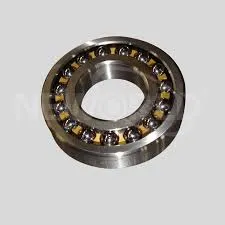
Dec . 03, 2024 22:20 Back to list
Exploring the Features and Applications of 33216 Roller Bearings for Enhanced Performance
Understanding the 33216 Bearing Features, Applications, and Maintenance
Bearings are crucial components in various mechanical systems, enabling the smooth rotation and movement of parts while minimizing friction. Among the many types of bearings available, the 33216 bearing stands out due to its unique design and performance characteristics. In this article, we will explore the features, applications, and maintenance practices associated with the 33216 bearing.
Features of the 33216 Bearing
The 33216 bearing is a tapered roller bearing, which is specifically designed to accommodate both radial and axial loads. Its construction consists of inner and outer rings, tapered rollers, and a cage that keeps the rollers evenly spaced. This design allows the bearing to handle higher loads compared to other types of bearings, making it suitable for heavy-duty applications.
One of the key features of the 33216 bearing is its ability to handle misalignment. The tapered rollers can adjust to slight deviations in shaft alignment, which helps in prolonging the bearing's life and maintaining optimal performance. The compatibility of this bearing with various shaft and housing designs adds to its versatility, making it a preferred choice in many industries.
Another notable aspect is the lubrication options available for the 33216 bearing. It can be lubricated with grease or oil, depending on the application and operational environment. Appropriate lubrication is vital for reducing friction and preventing wear, thereby enhancing the bearing’s lifespan.
Applications of the 33216 Bearing
Due to its robust design and outstanding performance characteristics, the 33216 bearing is widely used in various industries. Some of the prominent applications include
1. Automotive Industry The 33216 bearing is commonly used in wheel hubs, differential assemblies, and transmission systems. Its ability to handle heavy loads and provide smooth operation is critical in vehicles’ performance and safety.
2. Industrial Machinery In manufacturing and processing facilities, the 33216 bearing is found in conveyor systems, pumps, and other machinery that require reliable performance under high stress. Its load-bearing capacity and durability make it extensively used in these applications.
3. Construction Equipment Heavy machinery such as excavators, bulldozers, and loaders often utilize the 33216 bearing. These machines operate in harsh environments and require components that can withstand significant forces while remaining functional over time.
33216 bearing

4. Aerospace In the aerospace sector, precision and reliability are paramount. The 33216 bearing is utilized in various parts of aircraft, including landing gears and engines, where its performance can directly affect safety and operational efficiency.
Maintenance of the 33216 Bearing
To ensure optimal performance and longevity of the 33216 bearing, regular maintenance is essential. Here are some tips for maintaining this bearing
1. Regular Inspection Frequent checks for signs of wear, corrosion, or damage are vital. Look for abnormal noises or vibrations during operation, which can indicate potential issues.
2. Proper Lubrication Ensure that the bearing is adequately lubricated according to the manufacturer’s guidelines. Over-lubrication or under-lubrication can both lead to bearing failure.
3. Temperature Control Monitor the operational temperature of the bearing. Excess heat can accelerate wear and potentially cause failure. If the bearing is consistently running hot, investigate the cause and address any underlying issues.
4. Load Management Adhere to the bearing's load capacity to prevent overload situations. Exceeding the recommended load can lead to premature wear and eventual failure of the bearing.
5. Replacement of Worn Parts If signs of wear become evident, replace the bearing or its components as needed to maintain the efficiency of the entire system.
Conclusion
The 33216 bearing is a reliable and versatile component used across various industries due to its design and performance characteristics. Understanding its features, applications, and maintenance practices is crucial for ensuring optimal operation and longevity. By adhering to best practices, users can significantly enhance the performance of their machinery and systems, ultimately leading to cost savings and improved efficiency.
Latest news
-
Premium Deep Groove Ball Bearings | High Speed & Reliability
NewsAug.29,2025
-
Durable Scaffolding Clamps - Secure & Reliable Tube Connectors
NewsAug.28,2025
-
Common Failures in Thrust Ball Bearings and Solutions
NewsAug.22,2025
-
How Tapered Roller Bearings Can Take Shock Loads
NewsAug.22,2025
-
Angular Bearings in High-Precision Spindles
NewsAug.22,2025
-
The Impact of Misalignment on Cylindrical Roller Bearing Performance
NewsAug.22,2025
